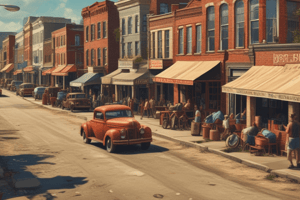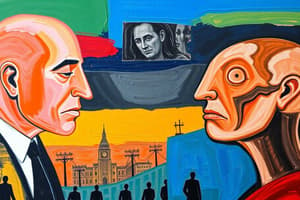Podcast
Questions and Answers
What was the approximate percentage decline in real GDP from its peak in 1929 during the Great Depression?
What was the approximate percentage decline in real GDP from its peak in 1929 during the Great Depression?
- 30% (correct)
- 40%
- 20%
- 10%
What was the peak unemployment rate during the Great Depression?
What was the peak unemployment rate during the Great Depression?
- 15%
- 20%
- 25% (correct)
- 30%
What type of organizations often ran soup kitchens during the Great Depression?
What type of organizations often ran soup kitchens during the Great Depression?
- Labor unions
- Government agencies
- Private businesses
- Charities and religious organizations (correct)
By how much did industrial production in the United States drop during the Great Depression?
By how much did industrial production in the United States drop during the Great Depression?
What percentage of the workforce was unemployed by early 1933?
What percentage of the workforce was unemployed by early 1933?
What was the primary purpose of soup kitchens during the Great Depression?
What was the primary purpose of soup kitchens during the Great Depression?
What type of programs were established to provide employment opportunities for young men during the Great Depression?
What type of programs were established to provide employment opportunities for young men during the Great Depression?
What was the primary focus of the Works Progress Administration (WPA) during the Great Depression?
What was the primary focus of the Works Progress Administration (WPA) during the Great Depression?
Which group did the Social Security Act of 1935 primarily aim to provide assistance to?
Which group did the Social Security Act of 1935 primarily aim to provide assistance to?
During the Great Depression, what were soup kitchens primarily established for?
During the Great Depression, what were soup kitchens primarily established for?
How did the Great Depression impact industrial production?
How did the Great Depression impact industrial production?
What is a key lesson learned from the Great Depression that influenced economic policy and theory?
What is a key lesson learned from the Great Depression that influenced economic policy and theory?
Flashcards are hidden until you start studying
Study Notes
The Great Depression
The Great Depression was a period of extreme economic hardship that lasted from 1929 to the late 1930s, characterized by high unemployment, poverty, and a significant decline in industrial production and economic activity. It was the longest and most severe economic downturn in the history of the United States and had profound social and political consequences.
Economic Impact
The Great Depression caused a sharp decline in economic output, with real GDP falling by approximately 30 percent from its peak in 1929. Industrial production in the United States dropped by 47 percent, and wholesale prices declined by 33 percent. The unemployment rate soared to over 25 percent at its peak in 1933.
Unemployment
Unemployment was a major issue during the Great Depression, with the number of unemployed workers rising dramatically. In 1930, there were 4.3 million unemployed, which increased to 8 million in 1931 and 12 million in 1932. By early 1933, almost 13 million were out of work, representing approximately one-quarter of the workforce.
Soup Kitchens
During the Great Depression, soup kitchens were established to provide food for the unemployed and destitute. These kitchens were often run by charities, religious organizations, and local governments. They provided a vital source of sustenance for those who had lost their jobs and were struggling to make ends meet.
Social Welfare Programs
In response to the economic hardships caused by the Great Depression, various social welfare programs were established to help support those in need. These programs included the Civilian Conservation Corps (CCC), which provided employment opportunities for young men in conservation projects, and the Works Progress Administration (WPA), which provided jobs for artists, writers, and other creative professionals. The Social Security Act of 1935 was also passed during this period, establishing a national social insurance program to provide assistance to the elderly, disabled, and unemployed.
Lessons Learned
The Great Depression had a significant impact on economic policy and theory, leading to changes in monetary and fiscal policies and the development of new economic models to better understand and address economic downturns. The experience of the Great Depression also influenced the implementation of the New Deal, a series of government programs aimed at providing relief, employment, and social reform during the 1930s.
In conclusion, the Great Depression was a period of extreme economic hardship that lasted for over a decade. Its impact was felt across industries, with industrial production plummeting, and unemployment soaring. Soup kitchens were established to provide food for the destitute, and various social welfare programs were introduced to support those in need. The lessons learned from the Great Depression have continued to shape economic policy and theory to this day.
Studying That Suits You
Use AI to generate personalized quizzes and flashcards to suit your learning preferences.




